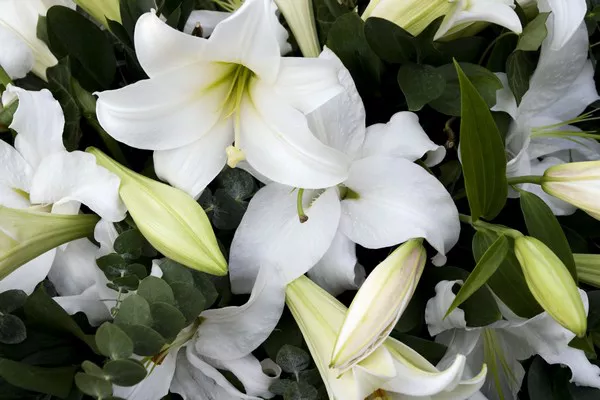Lilies, with their vibrant and elegant blooms, are a cherished addition to gardens and patios alike. Cultivating lilies in pots allows for greater versatility in terms of placement and care. Once these lovely flowers have finished their breathtaking display, it’s crucial to know how to care for lilies in pots after flowering to ensure their health and encourage robust growth for the following seasons.
Post-Bloom Maintenance for Potted Lilies
As the lilies in your pots begin to fade and their blooms wither, it’s time to shift your attention to post-bloom maintenance. Proper care at this stage can make a significant difference in the lilies’ overall health and future flowering potential.
Deadheading Lilies
Deadheading is the practice of removing spent blooms from the lilies. It not only enhances the plant’s appearance but also directs energy toward root and bulb development rather than seed production. To deadhead lilies in pots, carefully snip or pinch off the faded flowers just below the base of the bloom. This will encourage the plant to focus on strengthening its bulbs.
Maintaining Adequate Watering
After flowering, lilies still require consistent moisture to replenish their energy reserves. However, it’s essential to adjust your watering routine slightly. Reduce the frequency of watering, allowing the soil to dry out slightly between watering sessions. Be mindful not to overwater, as lilies are susceptible to root rot when soil remains waterlogged.
Fertilizing Potted Lilies
Feeding your lilies in pots is a crucial step in post-flowering care. Apply a balanced, slow-release fertilizer or a liquid fertilizer diluted to half strength. This should be done approximately every four to six weeks throughout the growing season. Fertilizing helps the bulbs build up essential nutrients for robust growth in the following year.
Pruning and Removing Foliage
As the lilies’ foliage begins to yellow and die back, it is tempting to remove it immediately. However, it’s essential to let the foliage wither naturally. The leaves continue to photosynthesize, providing nutrients to the bulbs for future growth. Once the foliage has turned completely yellow and can be easily detached, it’s safe to trim it down to the ground.
Storing Potted Lilies Indoors
In regions with harsh winters, consider storing your potted lilies indoors to protect them from freezing temperatures. To do this, gently lift the bulbs from the pots, being careful not to damage the roots. Shake off excess soil, and place the bulbs in a cool, dark, and dry location, such as a basement or garage. Ensure good ventilation to prevent mold or rot. Replant the bulbs in fresh soil when the next growing season begins.
Overwintering Lilies in Pots Outdoors
If you live in an area with mild winters, you may choose to overwinter your potted lilies outdoors. To do this:
a. Mulch the pots: Apply a thick layer of mulch over the soil in the pots to insulate the bulbs from extreme cold.
b. Group pots together: Placing the potted lilies close to each other can create a microclimate that offers some protection from freezing temperatures.
c. Elevate pots: Elevating the pots slightly off the ground can help prevent them from freezing to the surface.
d. Provide additional insulation: In exceptionally cold climates, wrap the pots with burlap or bubble wrap for added insulation.
Dividing Potted Lilies
Over time, lilies in pots can become crowded, leading to reduced flowering and overall health. To maintain vigorous growth, divide the bulbs every few years. Dividing lilies should be done in late summer or early fall when the bulbs are dormant. Carefully lift the bulbs from the pots and gently separate them, ensuring each division has healthy roots and shoots. Replant them in fresh soil, and you’ll enjoy more robust blooms in the coming years.
Pest and Disease Management
Keep a watchful eye for pests and diseases that can affect potted lilies, even after flowering. Common issues include aphids, lily beetles, and fungal diseases. Regularly inspect your plants for any signs of infestation or disease and take appropriate measures to address them promptly. Neem oil and insecticidal soap can be effective against pests, while proper sanitation and well-draining soil can help prevent fungal issues.
Enjoying the Off-Season
While caring for lilies in pots after flowering is essential for their long-term health, don’t forget to enjoy the beauty of your garden during the off-season. Consider planting other seasonal flowers or ornamental grasses in the pots to keep your outdoor space vibrant and visually appealing throughout the year.
Conclusion
Cultivating lilies in pots can bring unparalleled beauty to your garden or patio, and with proper post-flowering care, you can ensure that these exquisite flowers continue to thrive year after year. Deadheading, adjusting watering routines, fertilizing, and providing adequate storage or winter protection are all crucial aspects of maintaining healthy potted lilies. By following these guidelines and staying vigilant for pests and diseases, you can enjoy the enduring elegance of lilies in your pots for many seasons to come.


